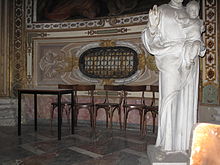- Dacius (bishop of Milan)
-
Dacius Archbishop of Milan 
Wall with the Urn of Saint DaciusChurch Catholic Church Appointed c. 530 AD Reign ended 552 Predecessor Magnus Successor Vitale Personal details Died 552
ConstantinopleSainthood Feast day January 14 Venerated in Catholic Church Dacius or Datius (Italian: Dazio) was Archbishop of Milan from c. 530 to 552. He is remembered as a defender of Catholic orthodoxy against the heresies of his day. An active ecclesiastical politician, he was an ally of Pope Vigilius in the latter's struggles against Justinian, involved in the Three-Chapter Controversy. He died at Constantinople in 552. He is honoured as a saint in the Catholic Church.[1][2][3]
His body was translated in Milan and buried in the Church of San Vittore al Corpo (Saint Victor Maurus) where it is still venerated. A late tradition, with no historical basis, associates Dacius with the Milan's family of the Agliati.
Dacius as exorcist
In Chapter 4 (Book 3) of his Dialogues, Gregory the Great tells a legend in regards to Dacius:[4]
In the time of the same Emperor, Datius, Bishop of Milan, about matters of religion, travelled to Constantinople. And coming to Corinth, he sought for a large house to receive him and his company, and could scarce find any: at length he saw afar off a fair great house, which he commanded to be provided for him: and when the inhabitants of that place told him that it was for many years haunted by the devil, and therefore stood empty: "so much the sooner," quoth the venerable man, "ought we to lodge in it, if the wicked spirit hath taken possession thereof, and will not suffer men to dwell in it." Whereupon he gave order to have it made ready: which being done, he went without all fear to combat with the old enemy. In the dead of the night, when the man of God was asleep, the devil began, with a huge noise and great outcry, to imitate the roaring of lions, the bleating of sheep, the braying of asses, the hissing of serpents, the grunting of hogs, and the screeching of rats. Datius, suddenly awaked with the noise of so many beasts, rose up, and in great anger spake aloud to the old serpent, and said: "Thou art served well, thou wretched creature: thou art he that diddest say: I will place my seat in the north, and I will be like to the highest: and now through thy pride, see how thou art become like unto hogs and rats; and thou that wouldest needs unworthily be like unto God, behold how thou dost now, according to thy deserts, imitate brute beasts." At these words the wicked serpent was, as I may well term it, ashamed, that he was so disgraciously and basely put down, for well may I say that he was ashamed, who never after troubled that house with any such terrible and monstrous shapes as before he did: for ever after that time, Christian men did inhabit the same; for so soon as one man that was a true and faithful Christian took possession thereof, the lying and faithless spirit straightways did forsake it. But I will now surcease from speaking of things done in former times, and come to such miracles as have happened in our own days.
Notes
- ^ Casari, Mario (1989). "Dazio, santo (sec. VI)". Dizionario della Chiesa Ambrosiana. 2. Milano: NED. p. 995 %dash; 996. ISBN 887023102X.(Italian)
- ^ Ruggeri, Fausto (1991). I Vescovi di Milano. Milano: NED. p. 18. ISBN 8870231542.(Italian)
- ^ Cazzani, Eugenio (1996). Vescovi e arcivescovi di Milano. Milano: Massimo. pp. 31-32. ISBN 887030891x.(Italian)
- ^ "Gregory the Great, Dialogues (1911) Book 3. pp. 105-174". CCEL. http://www.ccel.org/p/pearse/morefathers/gregory_03_dialogues_book3.htm#4.
Categories:- Archbishops of Milan
- 552 deaths
- 6th-century Christian saints
Wikimedia Foundation. 2010.
